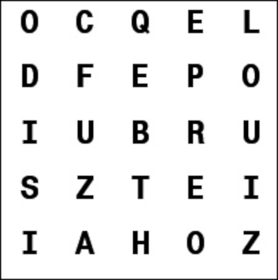Structures of spirituality – II
Dynamic structures of spirituality
The structural model of spirituality exemplified by the word search, described in the previous post Structures of spirituality – I – Word search, can be deepened and expanded.
Let’s imagine that the letters inside it are not still, but moving: they mix and remix continuously.

This will make possible to detect different words that will form randomly at different times. In certain cases, for the reasons that I am going to discuss here below, we could find not only words, but phrases, or even whole speeches. The criterion by which we can see words that are formed by the letters is not necessarily just what we’ve seen so far: we could find a word that is formed by taking letters in an alternating way, or by selecting some of them by proceeding in a zig-zag, or mixing either ordered and random geometric patterns; the result is that everyone can find anything among the letters, because everyone can invent on the spot new criteria to select them. Now let’s imagine that the word search is our brain, where our spirituality structures are. Our neurons are the letters, our ideas are the words that we can find. The same way how we can discuss whether the words are really in the word search, or it is just our imagination seeing them in it, it is questionable whether our ideas are truly present in our brain, or are just neurons connected more or less randomly, in such a way as to encourage in us the identification of structures that we call ideas.
Not only our structures of spirituality, but also the whole world, the entire universe, can be considered a word search. All atoms can be considered the alphabet letters and everyone sees what they want to see, depending on how they prefer to organize their own mind, their own thoughts.
The same way the letters of the alphabet differ from each other, atoms as well are all different; some are attracted to each other, others repel each other, some group and form objects, structures.
Let’s also note that any object can be able to have behaviors similar to those of a living being, despite not being alive. Viruses are such an example. If we think about computer viruses, it is easy to notice that in some ways they are able to behave like living beings: they can attack, defend, multiply, adopt strategies. Viruses causing disease in our body are considered scientifically halfway between simple chemical compounds and real living beings. It is difficult to consider them as real living beings, because they lack cellular organization and complex internal functions, as bacteria have.
Even an idea that lies within our brain (that is, a structure of connected neurons) can behave like a living being or like a virus: it can try to take possession of our brain (an example would be a song melody, that sometimes we cannot push away from our mind), spread to other minds, multiply, differentiate, defend, attack. At this point we understand that, in a strictly theoretical, materialistic, objectivistic perspective, there is no difference between living and non-living beings: a living being is nothing but a set of atoms arranged in a structure that has a degree of complexity. Our DNA is nothing but a set of molecules arranged in a structure.
Additional notes
Considering spirituality as made of structures can be perceived as a rationalist, schematic vision, aiming at caging spirituality. Such a structural approach might seem out of place for spirituality, which is usually conceived as spontaneity, abandonment, letting go of emotions, of the most indescribable perceptions. Actually, a correct consideration of structures, rationality, or critical sense, does not exclude things like freedom, spontaneity, imagination. Talking about structures, or even cages, means essentially talking about criticism, assuming a critical attitude, an attitude of critical research. Criticism, if is carried out in a complete, full, serious manner, cannot help but include, at a certain point, self-criticism. Self-criticism means ability to backtracking, self-denying. In this context of comparison between schematism and spontaneity, I find the critical attitude more complete. The critical attitude is able to make room for its opposite, something that I do not see so much in the other attitude, which is people who claim that spiritualily must speak to our heart and cannot be rationalized. In my experience they fall easily into actual schematisms, real structures, that they don’t notice or don’t like to acknowledge. If we want to be complete in our research about spirituality, we need to include all our faculties, therefore both criticism and abandonment to the intuitive, the irrational. The best way to do this is not following a middle ground or adding both things in a mixture. The idea that I find most effective for this purpose is comparing it to riding a bicycle. On a bicycle you keep yourself in balance not because you are in the middle or because everything mixes up, but because you continuously unbalance yourself slightly and alternatively to the right and to the left. Thanks to this practice you manage to keep riding on your bike. In this question about the relationship between rationality, schematism on one hand and spontaneity on the other, it is good to exaggerate a little in one direction, a little in another, taking advantage of the respective exaggerations. In this context we see that those who claim the irrational may have the limit of not acknowledging the patterns they are moving in; on the other hand, our critical sense may be incapable of seeing anything falling outside the horizon of what it is able to criticize. Sometimes it happens that what criticism cannot criticize is neglected, ignored, is treated as non existent. In all of this I believe that spirituality can take advantage of both sides, while trying to correct and compensate their exaggerations.
